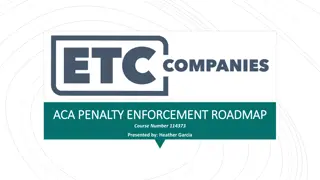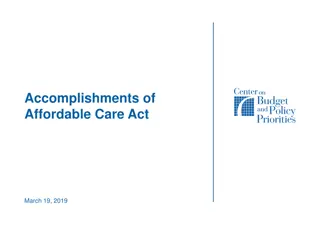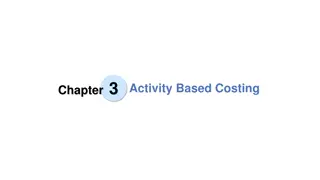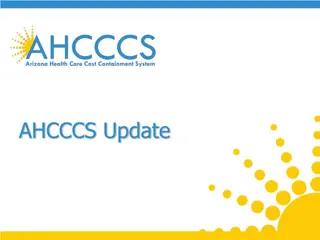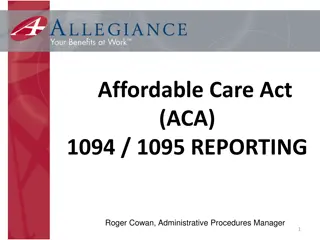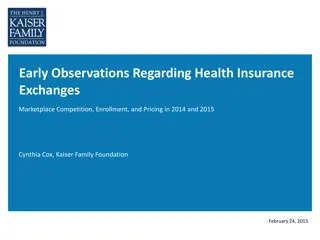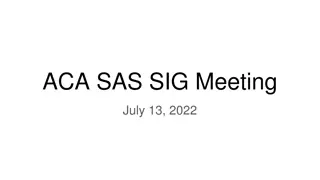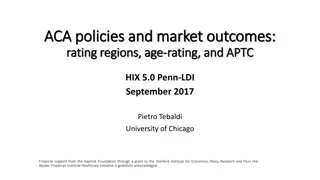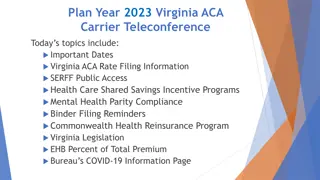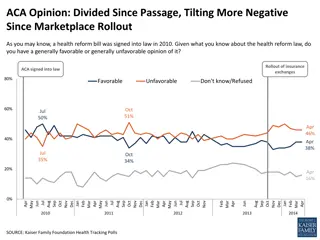Understanding the Status of ACA and Cost Mitigation Practices
Brief overview of the current state of the Affordable Care Act (ACA) and cost mitigation practices, including implications of the Trump executive order. Discussion on health care reform considerations under the new administration, focusing on employer-sponsored plans, Medicare, and potential changes in taxation and regulations.
Download Presentation

Please find below an Image/Link to download the presentation.
The content on the website is provided AS IS for your information and personal use only. It may not be sold, licensed, or shared on other websites without obtaining consent from the author. Download presentation by click this link. If you encounter any issues during the download, it is possible that the publisher has removed the file from their server.
E N D
Presentation Transcript
Understanding the Status of ACA and Cost Mitigation Practices Clay Austin Florida League of Cities This is only a brief summary that reflects our current understanding of select provisions of the law, often in the absence of regulations. All of the interpretations contained herein are subject to change as the appropriate agencies publish additional guidance.
Trump executive order on the ACA Trump executive order on the ACA January 20 order seeks to reduce burdens pending repeal Additional notes Agencies must make decisions about relief that will be granted; such decisions could be delayed pending approval of political appointees Executive order does not specifically refer to employer-sponsored plans May grant administration flexibility to address issues Congress does not (or cannot) include in legislation repealing or replacing the ACA Seeks to minimize the unwarranted economic and regulatory burdens of the ACA pending the law s repeal Directs agencies to waive, defer, grant exemptions or delay provisions imposing cost, fee, penalty or regulatory burdens on individuals, families, providers, insurers, patients, recipients of health care services, purchases of insurance, medical device and pharmaceutical manufacturers, to extent permitted by current law Scope and implications TBD based on agency implementation of the executive order
Health Care Health Care R Reform Considerations Under eform Considerations Under New Administration New Administration Employer-sponsored Plans Medicare Potential elimination of employer mandate (and reporting rules) Combine Parts A and B; add out-of- pocket maximum Health care benefit taxation (excise tax vs. exclusion cap) Part D coverage Medicare Advantage funding Cost management Medicare supplement plan design Prescription drug pricing Uncompensated care Provider/health system impact Expansion of means testing Carrier implications Higher eligibility age Conflicting rules on health status incentives (ACA and EEOC) Premium support (privatization) Expanded role for HSAs 5
Lower Tax Rates Three potential directions Three potential directions Less Regulation Health Care Changes Accelerate pension plan contributions Monitor capital market reactions Review pension asset strategy/mix Plan for the possibility of increased retirements Shift nonqualified pension liability to qualified plan and fund Fund retiree welfare liabilities via a qualified trust (VEBA), in a pension plan (401(h) account) or settle via a tax effective annuity Fund incurred but not reported (IBNR) claims for the active medical plan in a qualified trust (VEBA) in 2016 to ensure larger tax deduction Maintain status quo through relative pay mix Continue to comply with current rules and regulations Anticipate change and prepare for a range of potential actions; think through a few scenarios Update strategy and objectives in sponsoring group health care benefits Review plan design + delivery (cost management, employee engagement ) Consider potential impact on employees and retirees including future retirees Communicate with employees re: concerns and overall benefits value Stay the course relating to Dodd- Frank until there is more clarity Continue efforts on calculating your CEO Pay Ratio Do not expect significant movement on pay gap rulings Keep and broaden your clawback provisions Prepare for the fiduciary rule to be delayed, perhaps indefinitely Review and confirm existing human capital policies and procedures 6
Employer confidence in offering health care continues to grow How confident are you that your organization will continue to sponsor health care benefits to active employees in five years and in ten years, either via a self-managed plan or use of a private exchange? +10 73% 62% 59% 58% 57% 54% 44% 43% 38% 26% 25% 23% 2004 2006 2008 2009 2010 2011 2012 2013 2014 2015 2016 2016 - Public Sector & Education 7
Health care cost trend remains at historically Health care cost trend remains at historically low levels low levels Health care cost trends after plan changes are well above the rate of inflation. Employers under 1,000 lives appear more likely to make plan changes to address trend closer to 8%. 14.7% 13.0% 11.3% 10.3% 9.2% 9.0% 8.3% 8.0% 8.0% 8.0% 8.0% 7.0% 6.8% 6.8% 6.8% 6.4% 6.3% 6.0% 6.0% 6.0% 6.0% 5.0%5.3% 5.5% 5.5% 5.3% 5.0% 5.0%5.0% 5.0% 4.9% 4.2% 3.9% 4.0% 2001 2002 2003 2004 2005 2006 2007 2008 2009 2010 2011 2012 2013 2014 2015 2016 2017* 2015 - Public Sector & Education 2016 - Public Sector & Education 2017* - Public Sector & Education *Projected. Health Care Trend After Plan Changes (Total Plan Costs) Health Care Trend Before Plan Changes CPI-U 8
Whats driving variability in health care costs? What s driving variability in health care costs? Vendor Partner Strategy Determine entities best positioned to help you deliver on your strategy Health Care Delivery Maximize purchasing value of health care services Employee and dependent participation Single most significant predictor of per employee health costs Efficiency Participation Workforce Health Identify and effectively manage population health risks Engagement and Consumerism Increase participant engagement through shared accountability Pharmacy Manage specialty drug costs and leverage cost-effective options Program design value and subsidy level Define financial commitments based on overall program value Subsidization 10
Managing costs Managing costs - - Public Sector & Education Public Sector & Education #1 Priority is to evaluate health and pharmacy plan design strategy 92% 28% 19% 22% Plan to change health and pharmacy plan design as most important priority in the next 3 years Anticipate adopting spousal surcharge by 2018, compared to 3% today Structure employee contributions based on employees taking specific actions, which could reach 50% in two years Currently use defined contribution strategies, expected to increase to 47% by 2018 11
E Employers mployers embrace Sector & Education Sector & Education Offer telemedicine for professional consultations Offer telemedicine for professional consultations embrace telemedicine telemedicine Public Public 2016 64% 2017* 72% 2018^ 89% 31 31% % Of employers offer tele behavioral health or tele-psychiatry currently, expected another 44% by 2018 12
Low program participation lead companies to Low program participation lead companies to revisit their incentive strategy revisit their incentive strategy Use financial rewards for individuals who participate in health management programs/activities, which dropped from 77% in 2015 Of companies plan to increase their use of incentives over the next three years. Two-thirds plan to maintain current levels, while 10% plan to decrease or completely eliminate their use. Maximum incentive opportunity continues to rise but the pace slows. Are we approaching a plateau? 13
Use of incentives is changing Use of incentives is changing Public Sector & Education Education Public Sector & TOBACCO SURCHARGE: Reward (or penalize) based on smoker, tobacco-use status (tobacco surcharge) BIOMETRIC OUTCOMES: Reward (or penalize) based on biometric outcomes other than smoker, tobacco-use status $435 Median tobacco surcharge 51% 32% 32% 19% 3% 3% 2016 2017* 2018^ 2016 2017* 2018^ 14
Nearly two thirds consider health and well Nearly two thirds consider health and well- - being a core part of employee value being a core part of employee value proposition proposition To what extent do you agree with the following statements about your organization s approach to To what extent do you agree with the following statements about your organization s approach to health and well health and well- -being? being? Employee value proposition Health and well-being is a core part of our organization s employee value proposition All Companies 62% 24% 14% Public Sector & Education 67% 25% 8% Effective communication Our organization has a health and well- being strategy that is effectively communicated to employees and deliver on its promises All Companies 56% 26% 18% Public Sector & Education 53% 31% 17% Effectively improve Our health and well-being program has effectively improved employee health behaviors (e.g., program participation, health risk reduction) All Companies 38% 43% 20% Public Sector & Education 33% 44% 22% Customized and differentiated Our health and well-being program is customized for critical workforce segments and used to differentiate from other organizations with which we compete for talent All Companies 24% 35% 41% Public Sector & Education 19% 39% 42% 15
Conclusions: What can we learn from best Conclusions: What can we learn from best performers? performers? Employers take action to curb the cost of specialty pharmacy, focusing on price, utilization and delivery/site of care Examine health care benefits in a total rewards context with changes to plan design and account contributions that consider affordability for low-wage employees Understanding your population health is critical in selecting programs. Greater opportunities to broaden measurement to include non-financial metrics Lack of employee engagement warrants a review of program structure, vendor partners, and incentive strategy Consider care extenders, such as telemedicine and onsite/near site clinics, to enhance employee access, productivity, and convenience in a cost effective manner Greater emphasis on value-based arrangements through plan designs that encourage employees to utilize high-value services (quality and cost effectiveness) to maximize the value they receive from their health care benefit Put employees at the center of the health care strategy Enhance the member experience through more choice with decision support Expand well-being programs to address financial issues alongside physical, emotional and social Adapt the workplace environment to encourage good health habits 16
NEXT STEPS? This is only a brief summary that reflects our current understanding of select provisions of the law, often in the absence of regulations. All of the interpretations contained herein are subject to change as the appropriate agencies publish additional guidance.




